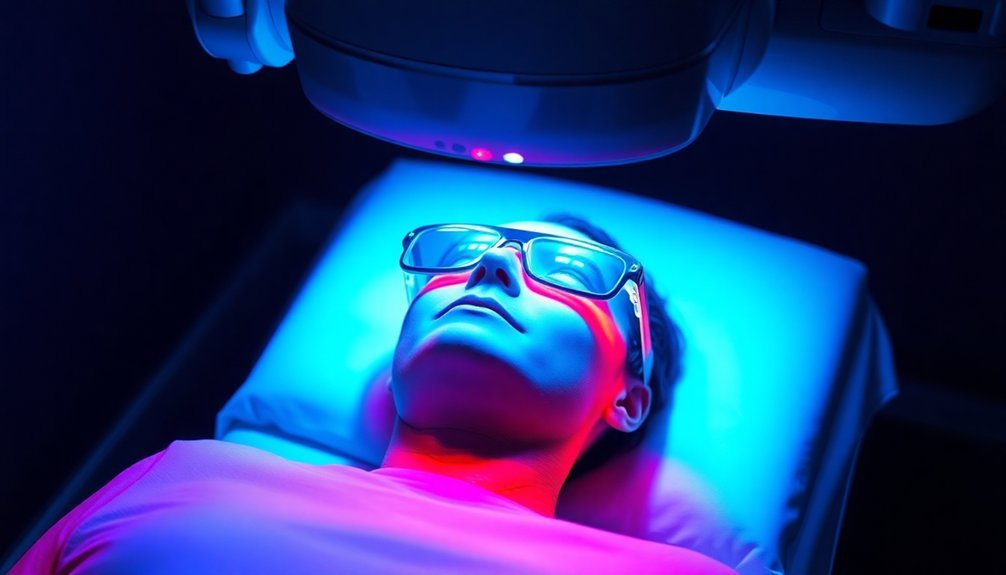Wavelength therapy offers three powerful brain-boosting benefits you'll want to know about. First, it can improve your working memory by 10-25% through non-invasive light treatment to your prefrontal cortex. Second, you'll experience faster mental processing as the therapy activates mitochondria and increases blood flow to essential brain areas. Third, specific wavelengths protect and regenerate neural tissue, promoting recovery and long-term brain health. These scientifically-backed benefits come from simply applying specific light frequencies to targeted brain areas. The deeper you explore this breakthrough therapy, the more remarkable its potential becomes.
Better Memory and Brain Flow

Breaking new ground in cognitive enhancement, wavelength therapy using 1064 nm light has shown remarkable promise in boosting memory performance. When you undergo this non-invasive treatment, you'll likely experience improved working memory, enabling you to remember 4-5 objects instead of the typical 3-4 in memory tasks.
The therapy's effectiveness has been confirmed through EEG monitoring, particularly when recalling orientations and colors of items on screen displays. The treatment has proven to be safe and side-effect free for participants.
You'll benefit from the therapy's ability to stimulate astrocytes and enhance nerve cell efficiency, while your brain's oxygen metabolism improves in cortical tissue.
What's particularly exciting is how this treatment works alongside exercise-based cognitive enhancement. When you combine wavelength therapy with regular physical activity, you're targeting multiple pathways to boost your brain function. Exercise increases your blood flow and promotes neurogenesis, while the 1064 nm wavelength therapy enhances your working memory through complementary mechanisms.
Together, they create a powerful approach to cognitive improvement, though researchers continue to study the long-term effects and underlying mechanisms to fully understand this promising treatment's potential.
Enhanced Mental Processing Speed
Research has shown that wavelength therapy can substantially boost your mental processing speed through several key mechanisms. When infrared light penetrates your brain at wavelengths between 1,060 to 1,080 nanometres, it activates your mitochondria and increases ATP levels, giving your neurons more energy to fire quickly and efficiently. Recent pilot studies demonstrated improvements of 5-20% in cognitive function among participants.
You'll experience faster cognitive processing because the therapy enhances regional cerebral blood flow, particularly in critical areas served by the vertebral and internal carotid arteries.
The increased nitric oxide levels from the treatment help your blood vessels become more flexible, delivering oxygen and nutrients to your brain cells more effectively. This improved circulation directly translates to quicker mental responses and enhanced processing abilities.
Studies have specifically demonstrated that if you're experiencing slower cognitive processing speeds, you'll likely see significant improvements with regular photobiomodulation sessions. The therapy's effectiveness has been validated through multiple clinical trials, where participants showed measurable improvements in their processing speed after receiving daily treatments over several weeks.
Unlike traditional brain stimulation methods such as ECT, this light-based approach offers a gentle yet effective way to enhance your mental processing capabilities.
Neural Recovery and Protection

Through extensive clinical trials, wavelength therapy has emerged as a powerful tool for neural recovery and protection, particularly when using the 633 nm wavelength spectrum.
You'll find that this specific wavelength substantially increases axon diameter and Schwann cell expression in damaged nerves, leading to enhanced regeneration and faster recovery times. The typical recovery period spans 6-12 weeks, though results can vary based on individual cases.
When you're looking at neural protection, both 633 nm and 660 nm wavelengths offer remarkable benefits. They'll help reduce oxidative stress-induced cell death while promoting neuroprotection in your brain and spinal cord.
You can receive these treatments through either invasive or noninvasive methods, as studies show they're equally effective at stimulating nerve regeneration.
The therapy's impact on neural recovery is particularly impressive. You'll see increased neurite outgrowth and improved nerve cell survival with consistent treatment.
If you're dealing with spinal cord injuries, you can expect reduced lesion size and enhanced motor and sensory recovery. What's especially promising is that targeted application of photobiomodulation can maximize these benefits, making it an increasingly valuable tool in neurological rehabilitation protocols.
Frequently Asked Questions
How Long Does Each Wavelength Therapy Session Typically Last?
You'll spend 5-20 minutes in red light therapy, 15-30 minutes for soft wave sessions, and 10-60 minutes with binaural beats. Green light therapy's duration isn't well-documented, so consult your healthcare provider.
Can Wavelength Therapy Be Safely Combined With Prescription Medications?
You'll need to consult your doctor before combining wavelength therapy with medications. While it's generally safe, some prescriptions can increase light sensitivity, and interactions aren't fully understood, so professional guidance is essential.
What Are the Costs Associated With Wavelength Therapy Treatments?
You'll typically pay $150-450 per session for wavelength therapies like ESWT or SoftWave. A complete treatment plan can cost $900-2,400, though prices vary by location and your specific condition's requirements.
Is At-Home Wavelength Therapy Equipment as Effective as Professional Treatments?
You can achieve similar benefits with quality at-home devices using proper wavelengths, though professional treatments offer deeper penetration, broader coverage, and expert oversight. Each option has unique advantages depending on your needs.
How Soon After Starting Wavelength Therapy Can Patients Expect to See Results?
You'll often notice initial changes after your first wavelength therapy session, but you'll need multiple treatments over 6-12 weeks for significant results. Your specific condition and health factors will influence the timeline.
In Summary
You've discovered how wavelength therapy can transform your brain health through three powerful benefits: improved memory and circulation, faster cognitive processing, and enhanced neural protection. By incorporating this innovative treatment into your routine, you'll tap into your brain's potential for sharper thinking and better overall function. Don't wait to give your mind the boost it deserves – start exploring wavelength therapy today.





Leave a Reply